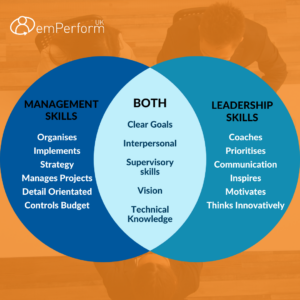
Leadership and management are often used interchangeably, yet they encompass distinct skill sets and responsibilities. Stephen Covey articulates this difference by stating, “Effective leadership is putting first things first. Effective management is discipline, carrying it out.” Both are essential for organisational success and understanding their distinctions enables businesses to leverage the strengths of each. This blog explores the differences between leadership and management, highlighting their roles, attributes, and how they complement each other in a successful organisation.
Leadership VS Management
According to Gallup, employees who strongly agree they trust the leadership of their organisation are 4.0 times as likely to be engaged and 58% less likely to be watching for or actively seeking a new job. Leadership is the art of inspiring and motivating individuals toward a shared purpose. Leadership encompasses setting a vision, influencing others, and driving change through innovation and creativity. Leaders prioritise the bigger picture and guide their teams through challenges by cultivating a culture of trust and motivation. In contrast, management is the process of planning and coordinating resources to achieve specific goals. Gallup also found that 70% of the variance in team engagement is determined solely by the manager, proving the importance of the managerial role. Managers implement strategies to ensure the smooth operation of day-to-day activities. They emphasise structure, efficiency, and the tactical aspects of an organisation through their authoritative position.
The Difference Between Leadership & Management
A leader invents while a manager organises
Leaders are often visionaries who look beyond the current situation, pushing boundaries and exploring new possibilities. They thrive on innovation, encouraging creative problem-solving and inspiring others to think outside the box. Their focus is on setting a long-term vision and motivating their teams to pursue it with passion and enthusiasm.
On the other hand, managers are adept at organising resources, streamlining processes, and ensuring that everything operates efficiently. They concentrate on the practical aspects of the organisation, such as planning, coordinating, and maintaining control over day-to-day activities. Their strength lies in optimising systems and procedures to achieve specific objectives effectively and reliably.
Managers rely on control
Managers ensure teams follow procedures and meet targets using systems and structures, balancing oversight with autonomy to avoid micromanagement. This approach fosters high standards and performance, especially during new system implementations, where strategic oversight ensures policy adherence and measurable results. Balancing guidance with autonomy empowers employees, drives innovation, and fosters a culture of accountability and continuous improvement.
Managers count value whereas Leaders Create Value
Managers focus on measuring performance, tracking metrics, and achieving set goals. Their role is to enhance productivity and reduce inefficiencies. Leaders, however, strive to create value by inspiring change, driving innovation, and fostering an environment where innovative ideas can flourish.

How to Lead
Effective leadership requires a blend of various attributes and skills. Here’s how to lead successfully:
Inspire People
A great leader excels at inspiring and motivating their team by creating connections with each individual. They take the time to understand the unique strengths, aspirations, and challenges of team members, cultivating a supportive environment based on trust and empathy. Through clear communication and leading by example, they articulate a compelling vision that aligns with the team’s values and goals. This approach fosters a sense of commitment and loyalty, encouraging continuous growth, innovation, and personal development. Ultimately, under their guidance, each team member feels empowered to achieve their full potential and contribute effectively to the collective success of the organisation.
Vision
Leaders excel by offering a clear and compelling vision for the future and articulating long-term goals that guide the organisation’s direction. They effectively align their team’s efforts to achieve these objectives by communicating this vision and establishing a strategic path forward.
To ensure these goals are pursued effectively, employing SMART Goals and goal management practices is essential. These tools provide a structured framework for setting, monitoring, and tracking employee goals, ensuring alignment with the broader organisational vision. This approach not only enhances goal clarity but also drives accountability and facilitates ongoing achievement of the envisioned future.
Honesty and Integrity
Trustworthiness is a cornerstone of effective leadership. Leaders build credibility by demonstrating honesty and integrity, consistently ensuring that their actions align with their words. This alignment fosters a trusting environment where employees feel valued and understood.
An effective way to reinforce trustworthiness and show genuine concern for employees’ perspectives is through upward feedback. By actively seeking and integrating honest feedback from team members, leaders demonstrate their commitment to continuous improvement and responsiveness to employee input. Upward feedback not only enhances leader accountability but also empowers employees to share their insights, fostering a collaborative culture where their opinions directly contribute to leadership practices and organisational decisions. This approach strengthens the leader-employee relationship and underscores a leader’s dedication to transparent and trustworthy management.
Communication Skills
Effective communication is essential for leadership. Leaders must clearly convey their vision, actively listen, and foster open dialogue within their teams. Using surveys and 360-degree feedback with emPerform enhances this process by collecting comprehensive feedback, identifying areas for improvement, and promoting transparency, refining communication strategies, and strengthening team dynamics.

How to Manage
The Ability to Direct
Managers are crucial in providing clear direction and setting precise expectations for their teams. They are responsible for ensuring that tasks are completed on time and meet the required quality standards. This involves detailed planning, resource allocation, and continuous monitoring of progress. By using ongoing feedback mechanisms, managers can offer real-time guidance, address issues as they arise, and make necessary adjustments. This approach not only helps in meeting deadlines but also enhances the quality of work, fostering a culture of continuous improvement and accountability within the team.
Execute a Vision
While leaders are tasked with setting the vision, managers play a pivotal role in executing it. They translate high-level strategic goals into actionable plans, creating detailed roadmaps that guide their teams toward achieving these objectives. Managers oversee the implementation of these plans, ensuring that every step aligns with the overall vision. Succession planning is an integral part of this process, as it prepares employees for future roles and responsibilities, ensuring continuity and readiness for growth. This not only supports the organisation’s long-term goals but also helps in building a robust and agile workforce capable of adapting to future challenges.
People Focused
Effective managers excel in managing people by balancing organisational needs with individual strengths and weaknesses. They provide tailored support and guidance, helping team members grow and succeed in their roles. Implementing comprehensive employee benefits and fostering a positive work environment are key strategies in this regard. These efforts contribute to higher employee satisfaction, retention, and productivity. Managers who focus on the well-being of their teams create a supportive and engaging atmosphere that encourages open communication, collaboration, and a shared commitment to the organisation’s success. This people-centric approach not only enhances team morale but also drives overall organisational performance.

How to Measure Effective Leadership and Management
Measuring the effectiveness of leadership and management involves evaluating various aspects of organisational performance:
Team Performance
Effective leadership and management play a crucial role in driving high performance within teams. Evaluating team output, the quality of work, and the achievement of goals is essential to this process. emPerform’s performance reviews feature provides a comprehensive and user-friendly platform for monitoring these key aspects. By leveraging this tool, leaders can gain valuable insights into individual and team contributions, track progress toward organisational objectives, and ensure that performance standards are consistently met. This systematic approach not only facilitates the assessment of productivity and quality but also fosters a culture of continuous improvement and accountability.
Employee Engagement
Leadership significantly influences employee morale and engagement, which are critical for a thriving workplace. Understanding how motivated and satisfied employees feel within the organisation can offer insights into the effectiveness of leadership and overall workplace environment. To measure these aspects, consider conducting regular employee engagement surveys. Our blog on Employee Engagement Survey Questions provides a detailed guide on crafting effective questions to gauge employee motivation, satisfaction, and engagement. These insights can help you identify areas for improvement, boost morale, and create a more engaged and productive workforce.
Innovation and Growth
Leadership effectiveness is often reflected in an organisation’s capacity to innovate and grow. Effective leaders inspire and manage change by initiating and supporting new projects and ideas. Monitoring the success rates of these new initiatives and evaluating overall business growth are essential to understanding leadership impact.
Additionally, mentoring programs for employee development play a pivotal role in this context. By fostering a culture of learning and professional growth, mentoring helps employees enhance their skills, adapt to changes, and contribute to the organisation’s success. Tracking these developmental efforts alongside business growth metrics provides a comprehensive view of leadership effectiveness and its contribution to sustainable innovation and development within the organisation.
Operational Efficiency
emPerform’s reporting and analysis software is a powerful tool for evaluating process efficiency and achieving operational targets. It provides managers with comprehensive insights into key metrics and performance indicators, enabling them to conduct thorough analyses of workflows and operational processes. By leveraging real-time data, managers can identify areas for improvement, optimise resource allocation, and make informed decisions to streamline operations effectively.
Furthermore, the software supports ongoing monitoring of progress towards operational targets. Customisable reports and dashboards allow managers to track goal attainment and performance trends, facilitating proactive adjustments to ensure timely and successful outcomes. This data-driven approach not only enhances management efficiency but also fosters a culture of continuous improvement within the organisation, driving sustainable growth and operational excellence.
Feedback and Development
Utilise emPerform’s ongoing feedback and succession planning features to gather and utilise team members’ feedback on leadership and management practices. This continuous feedback loop helps identify areas for improvement in communication, decision-making, and support for employees. By integrating this feedback into succession planning, organisations can effectively develop future leaders aligned with organisational goals and enhance overall leadership effectiveness.
Understanding the distinct roles of leadership and management allows organisations to harness the strengths of both. Leaders drive vision and innovation, while managers ensure this vision is realised through effective execution and control. Both roles are crucial for long-term success and growth. Dr. Dean McCall highlights this balance, noting, “Management and leadership are separate roles, but they aren’t necessarily multiple people,” suggesting that individuals in authority can effectively combine these roles.
In the modern digital landscape, leveraging performance management software like emPerform can streamline operations and support effective leadership and management. With capabilities such as goal setting, performance reviews, and real-time feedback, emPerform enables leaders to oversee their teams efficiently. This software enhances operational efficiency and fosters a positive workplace culture focused on accountability and ongoing development.
